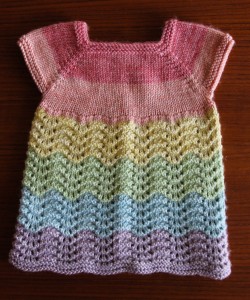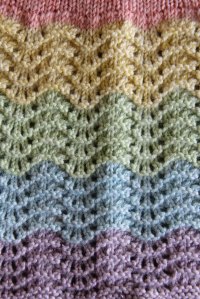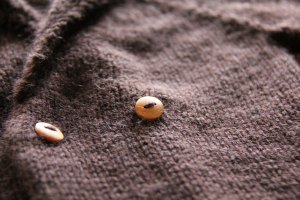I’ll start by putting it out there. I could have done better. And if I didn’t have a ‘to knit’ list as long as my arm and several fast approaching deadlines (also known as due dates), I probably would have frogged this and re-knit it. But here we are and it is the way it is. I’m hoping it still finds a very happy home.
My gorgeous rainbow mini skeins from Gradient have been realised this sweet little dress.
Pattern: Meadow Sweet Baby Dress by Marianna Mel
Source: Ravelry download
Price: Free!
Yarn: Rainbow Mini Skeins in 8ply from Gradient Aus (used ~120g)
Needle: 4mm (I knit on circulars as you end up with 164 stitches at one point)

Not happy with my colour change timing. The skirt starts visual on the increase row but I didn’t change colour until the start of the 4 row lace repeat.
The main reason for contemplation of frogging here was the way I divided the colours. I used a new colour every 17 rows on the bodice and every 4 repeats (16 rows) on the skirt. Given my time (and yarn) again, I would use one colour for the whole bodice, change to the first skirt colour for the increase row (row 33) and change colour every 3 or 4 repeats for the skirt. The change in colour mid-bodice looks strange and the skirt starts visually on the increase row but I didn’t change to a new colour until the start of the lace repeat resulting in a slightly awkward look.
The pattern calls for the first stitch of most rows to be slipped, which I did purl-wise—an inspiration from my Pekapeka knits—giving a very neat vertical edge. I also used markers during the bodice to help me knit the raglan sleeves without having to concentrate too much on my counting.
I’ve also been exploring the world of the ‘loose cast-off’. Patterns often call for this and I’m never quite sure I’m achieving it. So a quick Google sent me here where I found two techniques for ensuring a loose bind off. I used the ‘yarn-over’ method for this project as the skirt is ruffly and a super loose cast-off helped it show off its ruffles! The description of this technique puzzled me slightly in terms of how to get started.
I knit the first stitch, then did a yarn over and knit the second stitch. I then passed the yarn over loop over the second knit stitch and then passed the first stitch over the second stitch. Then did a yarn over and knit the next stitch. I continued in this way always putting the yarn over loop over first. Is that a better explanation?!
The other new thing for me with this knit and my Little Boy Blue was trying a different (gentler) technique for blocking. I recently bought some blocking mats from Knit Picks so after years of spreading beach towels over guest beds and then poking holes in them with my sewing pins—much to my husband’s dismay—I was able to neatly lay things out on my purpose built mats. The box came with instructions on how to block and I was rather surprised to see I’ve been doing it wrong!
I have always drenched my knit in warm water, often giving it a good few squeezes to get the water into the knit, then squeezing it again to get most of the water out. I think this has been beating my knits up a bit. I did notice recently that one of my Composite cardigans, done in a delicate silk blend yarn looked considerably more fuzzy and little worse for wear after blocking. The results with this new technique were much nicer!
The Knit Picks instructions are as follows (paraphrased for brevity):
- Soak knit in basin of lukewarm water until completely wet (usually at least 30 minutes). Very gently squeeze out any air bubbles.
- Remove from basin and put into sink to drain. Avoid wringing or twisting. Once most of the water is out, gently press knit between two towels to remove additional water.
- Carefully lay project out onto blocking mats away from direct sunlight or any heating vents. Shape according to pattern and use pins to secure project in place.
- Allow to air dry before removing pins.
Now to find some suitably gorgeous and girly buttons for the back!











